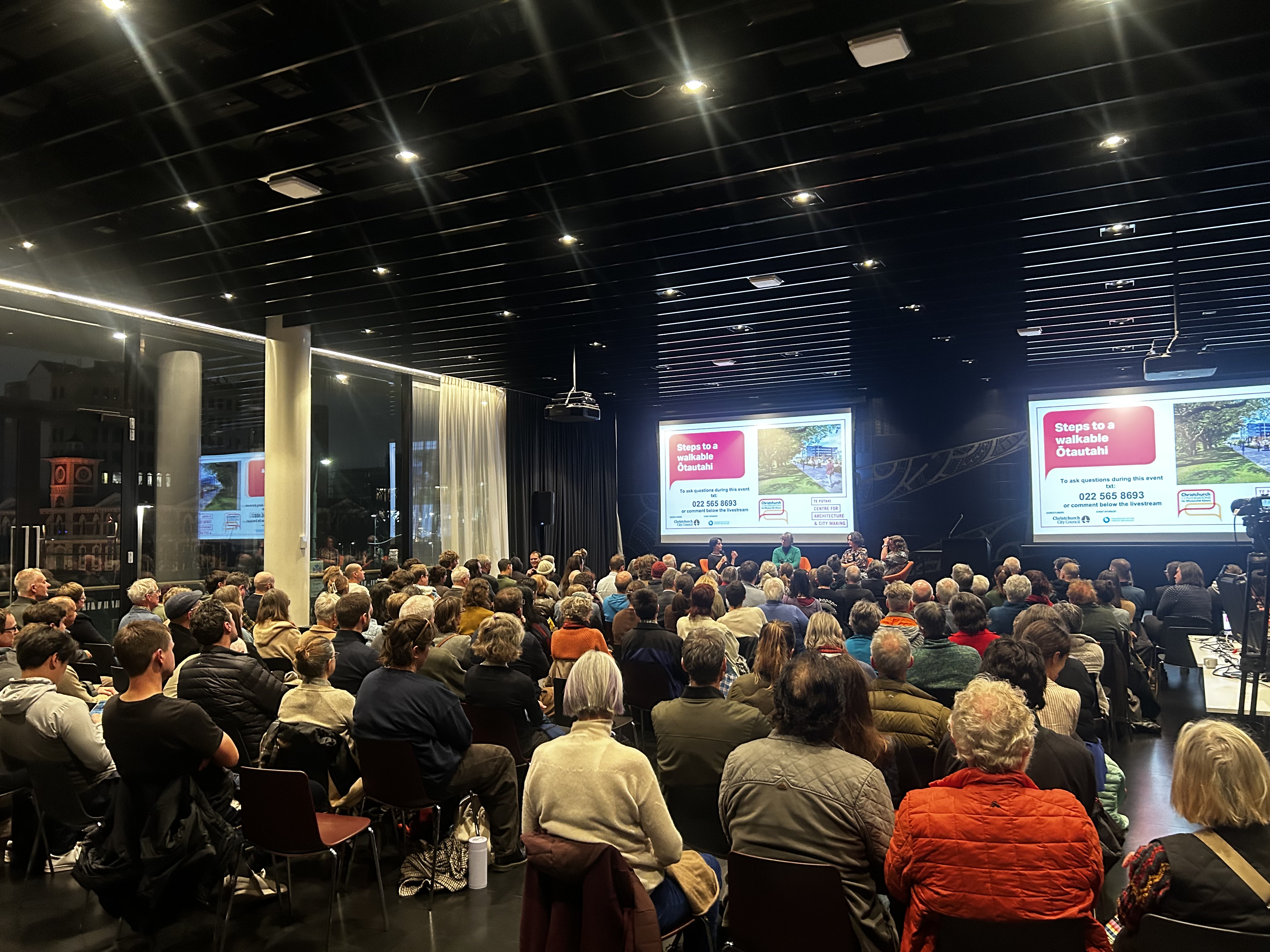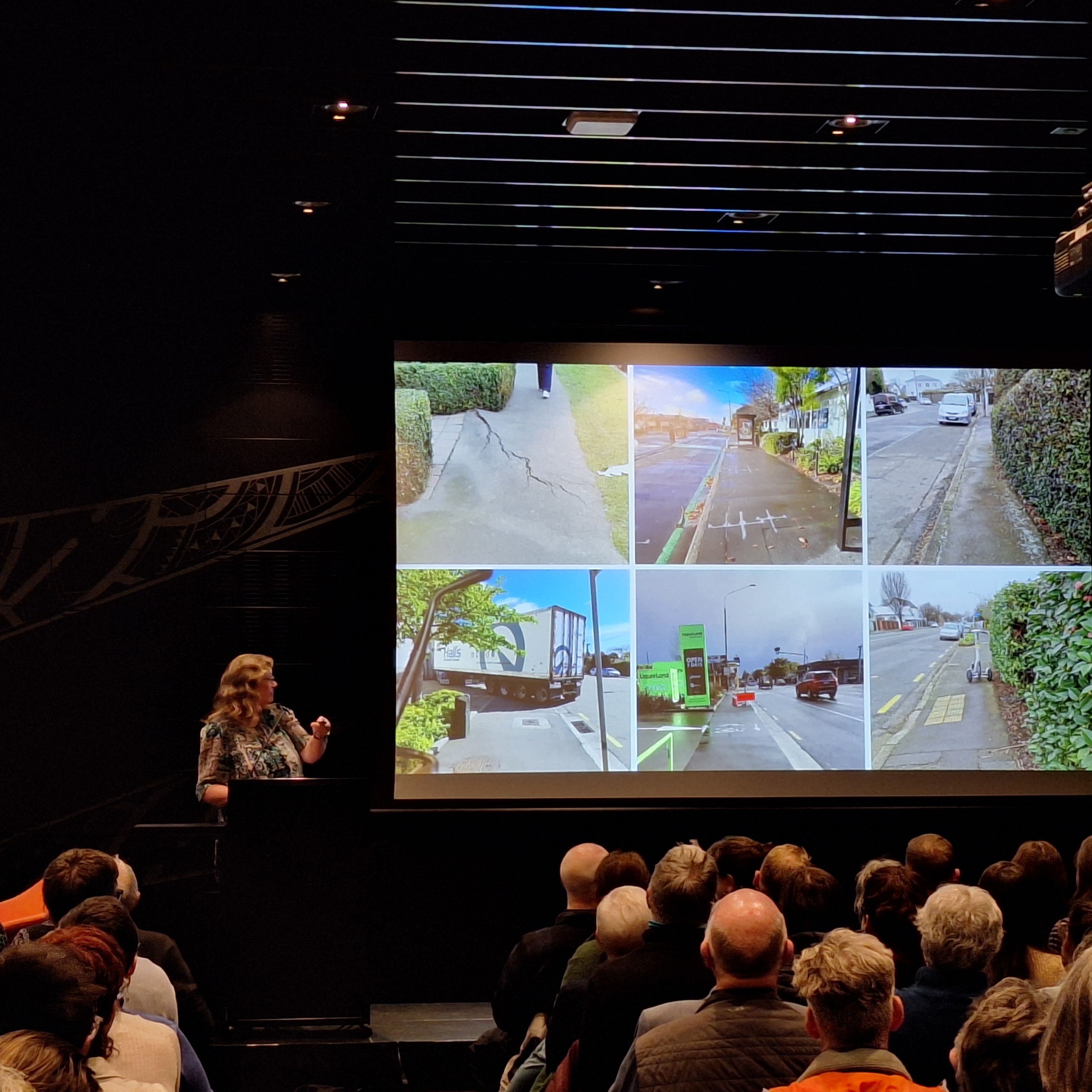By Molly Magid, Communications and Campaign Assistant for Living Streets Aotearoa
 When Dr. Jessica Halliday, director of Te Pūtahi Centre for Architecture and City-making, walked into the recent Christchurch Conversations event “Steps to a more walkable Ōtautahi”, she was audibly surprised at the turnout, saying: “Wow, the room is full!”
When Dr. Jessica Halliday, director of Te Pūtahi Centre for Architecture and City-making, walked into the recent Christchurch Conversations event “Steps to a more walkable Ōtautahi”, she was audibly surprised at the turnout, saying: “Wow, the room is full!”
As one of the audience members in that room, I have to admit, I shared her sentiment. After spending the past six or so months as communications and campaign assistant at Living Streets Aotearoa, I was fully on board to learn about what could make the place I live more walkable. But I wasn’t aware that this topic would draw such a huge crowd of people interested in walkability, especially in Ōtautahi, which one member of the crowd described in a comment as “a city shaped by car-dependency”.
So it was a very pleasant surprise indeed to see an in-person audience of about 200 plus 276 viewers online tuning in to learn about making Ōtatutahi more walkable.Though perhaps Jessica and I shouldn’t have been so surprised at the high attendance, because, as discussed in a recent Bike Auckland article, there is overwhelming support for people-friendly, walkable spaces. For example: “Auckland Council’s 2023 Deliberative Forum...found 95% support for walkable spaces and upgrades to rail."
The audience had come to hear more from three panelists: Carina Duke, LSA Executive Council member, Jeanette Ward, Technical Director of Transportation Engineering at Abley, and Dr Anna Stevenson, a public health physician in the National Public Health Service Te Whatu Ora. All speakers shared their perspectives and ideas for how making changes to improve walkability could make for a more accessible, safe, healthy, vibrant, sustainable and liveable Ōtautahi.
Here are three key changes the panelists suggested to make Ōtautahi more walkable:
- Denser, more connected suburbs. In low to medium density suburbs there is a lack of proximity to amenities like supermarkets and secondary schools. Only 40% of Christchurch residents live within a 15 minute walking distance of key amenities. Plus, there are often missing path links where footpaths end or where there are minimal pedestrian crossings. This means that while the centre of the city is relatively walkable, getting from suburbs on the outskirts to the central city can be difficult. Changing density restrictions in outer suburbs and improving footpath networks could help address this issue.

- Accessible, separated footpaths. Footpaths should be wide enough to allow pedestrians to easily pass one another, which includes people using mobility devices and pushing prams. Accessible footpaths should have curb cuts and smooth pavement without trip hazards. They also shouldn’t have obstacles like e-scooters, restaurant signs, parked cars, and overhanging vegetation.
Footpaths should also be separated, not shared paths that put foot traffic and cyclists in the same space. Since these two modes of transport have very different speeds, making cyclists and pedestrians use the same shared path can lead to safety issues for both groups. The best design for everyone is to have both a separated cycleway/lane and a footpath.
If footpaths are accessible, separated, and safe, then more people will use them. Carina Duke shows photo examples of poorly designed and maintained footpaths
- More signalised and raised pedestrian crossings. Pedestrians also need to be safe and should be given priority when crossing roads. The gold standard for crossings are signalised and raised crossings that prompt drivers to stop and make them slow down on the approach to crossings. Having better and more frequent crossings will help pedestrians to cross busy roads and get around easier.
I found it interesting that these key changes lined up with the conclusions of a recent global analysis about how to increase walking in cities, which was explored in a previous LSA blog. That research study also found that increasing urban density and more walking infrastructure are the main factors associated with higher rates of walking in cities.
And Christchurch is already making some changes to become more walkable. For example, the panelists brought up the redesign of a roundabout in Cashmere where raised platforms, speed humps, and zebra crossings were installed to improve safety and connectivity for pedestrians. Making these kinds of changes gives more people the opportunity to walk. As panelist Jeanette Ward said in an interview about the event: “It’s not about forcing people to walk, but giving people the choice."
You can watch the full recording of the event on Te Putahi’s Youtube channel.
And if you’re interested in learning more about walkability and pedestrian-centred design, come to the 2025 Living Streets Aotearoa Walking Summit! The summit is being held as a one-day virtual event on Thursday 6 November, and the theme is “walkable communities for wellbeing”. The summit will share best practice for working with communities, prioritising pedestrians, guidance and policy for making our streets safer for walking, showcasing innovations and exploring the health benefits of creating walkable streets. Register here.
